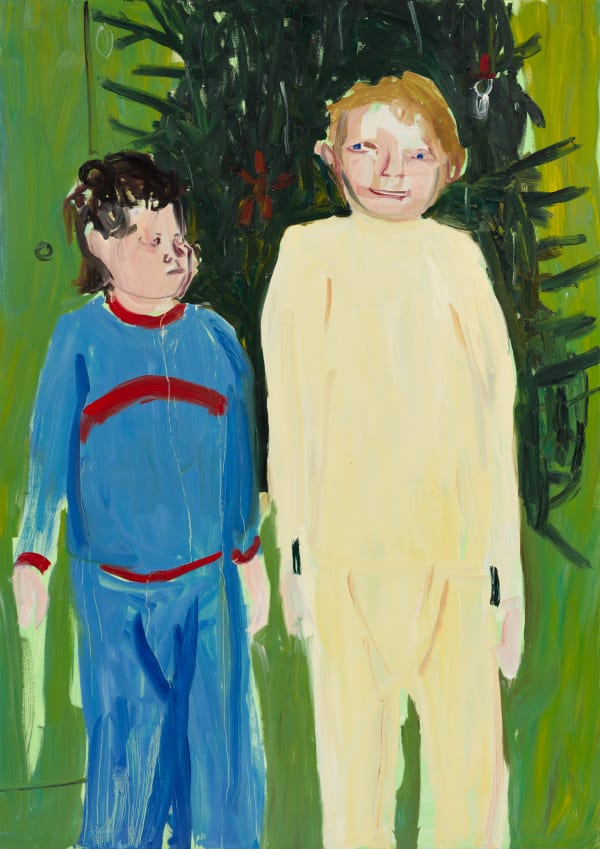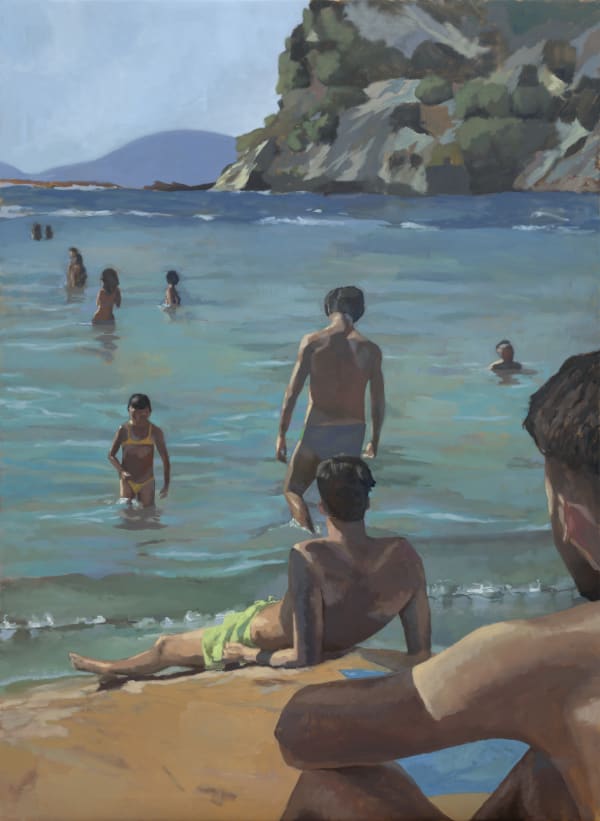Olivia Laing considers the non-linear nature of time in relation to Chantal Joffe's new paintings, on view in the artist's solo exhibition I Remember.
-
I recently had a conversation with a writer about time. She had written a memoir about trauma, and how trauma reconfigures one’s understanding of time, disrupting the usual orderly chronology of past, present and future into something more chaotic and disturbing. This led her into an exploration of various philosophies of time, all of which expose inconsistencies in our intuitive, common-sense understanding of how time functions. For example, in presentism only that which exists in the present moment exists at all. In eternalism, on the other hand, the past, the present and the future all simultaneously co-exist, and there is no objective flow of time at all.
This conversation came back to me after seeing the paintings that constitute I Remember, Chantal Joffe’s profound meditation on the past and its capacity not just to invade the present, but to take on new forms as time passes. This is the strangeness of ageing, the way in which one’s inexorable journey away from childhood paradoxically opens up new vistas on the past, illuminating that which is supposedly done and dusted in unexpected ways.
-
 Chantal Joffe, Matrushka Dolls, 2025
Chantal Joffe, Matrushka Dolls, 2025 -
The paintings in I Remember depict scenes from Joffe’s own childhood, mostly in America in the 1970s. Similar versions could no doubt be found in any family album of the period. Beach holidays, Halloween outfits (though few mothers could have achieved the creative heights of the three matryoshka dolls), a Christmas tree, a bespectacled dad holding a baby. But instead of snapshots, these are monumental paintings, not quite in focus, their uncertain presence almost spooky.
‘Something has definitively changed in the handling of paint. Joffe has allowed herself a new indefiniteness, a surrendering of precision and edge in favour of softness, saturation, blur.’
Something has definitively changed in the handling of paint. Joffe has allowed herself a new indefiniteness, a surrendering of precision and edge in favour of softness, saturation, blur. I can hardly say how exciting I find this shift. Gone is the desire to illustrate a story. These new paintings are more spectral and disquieting. Their irresolution, their tremulous quality, is right at the heart of their considerable power, their disturbing heft. -
 Chantal Joffe, Divers, 2025
Chantal Joffe, Divers, 2025 -
What I noticed first was the strangeness of the children’s faces. They haven’t quite formed; they’re caught in a transition between one expression and another. Exposed rather than composed, as faces tend to be these days. It’s somewhere between the artlessness of a family snap, shot on film in an era long predating editing software, and the restlessness, the fluidity of life itself. It’s actually inimical to paint, and yet they seize the unformed instant.Three girls on the dock, poised to dive, their arms outstretched. The water looks grey, the woods beyond a little foreboding. I’m guessing it’s Vermont. They’re skinny, pale, knobbly-kneed. You can almost hear their teeth chattering with cold. But their faces haven’t been clarified or corrected. There’s no attempt to fill any missing gaps in the record. They look tenuous, unstaged, not quite coherent. I’m reminded of how my sister, small, had to learn how not to grimace for the camera, to produce a ‘real’ smile.
-
 Chantal Joffe, Bananafish, 2025
Chantal Joffe, Bananafish, 2025 -
In Bananafish (the title refers to a Salinger story), this family unit of three expands to include the figures of mother and son. More rictus grins, more long bare legs. The mother, red-headed, barely has a face. She is, as we say, abstracted, bent on her own concerns, her gaze directed not at the viewer but at the sand. Her orange bucket is a slab of pure colour amid the unsettled blues and lavenders of reflected sky in shallow seams of Florida sea.
-
 Chantal Joffe, Jasna, 2025
Chantal Joffe, Jasna, 2025 -
In Jasna, she’s even more separate, dominating the scene, her gaze challenging, an abstract all-red painting shining like a beacon behind her head. The fierce vertical stripes on her polo neck and flares emphasise her determined individuation. The three little girls are crowded into the far side of the frame, piled around a second woman, her body almost hidden by theirs. As a portrait of maternal ambivalence, it’s hard to beat.
‘…we move from the known to the unknown, from a past we remember but cannot influence to a future we can influence but do not know.’
There is another theory of time, known as time’s arrow. It refers to how time moves in one direction only, from the past into the future, its unidirectional passage revealed by an increase in entropy. Thus we move from the known to the unknown, from a past we remember but cannot influence to a future we can influence but do not know. This is, as we might say, the human condition, and it is why we are so compelled to turn back to the past in search of comfort and security. Things seemed so much simpler then. But that past was once the present, and its inhabitants also experienced their own unbearable accumulation of debris, the combination of loss and chaos that is the inevitable consequence of living inside time. -
 Chantal Joffe, Backyard, 2025
Chantal Joffe, Backyard, 2025 -
A presentist might say they have ceased to exist, vanished from the frame, but like black holes, the dead continue to exert their influence. It’s not possible to say that they are gone completely when they still occupy the memory, still shape unfolding events, still affect relations between the living. For a long time, the grown child seeks to anchor themselves in time, to defeat the inevitable accumulation of absence and entropy by creating their own definitive version of how it was, a family romance that provides a sense of safety and control, even when it concerns events that were anything but.
‘These are works of maturity. What they convey is fluidity, uncertainty, curiosity. I’m not so sure, they seem to say. Is this how it was?’
That isn’t what the paintings in I Remember are doing. These are works of maturity. What they convey is fluidity, uncertainty, curiosity. I’m not so sure, they seem to say. Is this how it was? In this way, they manage to keep the past in flux, not gone. They are extraordinarily alive.Olivia LaingText © Olivia Laing -
Chantal Joffe: I Remember
→ Explore
-
Explore gallery exhibitions
-

Chantal Joffe: I Remember
14 November 2025 – 17 January 2026 London Gallery IThe exhibition takes its title from Joe Brainard’s iconic memoir and is inspired by the late American writer’s poetic prompts that evoke the atmosphere and time of memories. Joffe’s paintings... -

The Stories We Tell: Tidawhitney Lek, Emil Sands, Khalif Tahir Thompson
14 November 2025 – 17 January 2026 London Gallery II, Miro PresentsThe first significant introduction of three emerging artists, all born in the 1990s, to a London audience.
-






